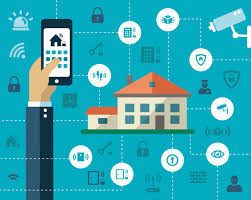HomeKit – Apple’s next Big Thing?

Apple – the world’s largest public company reported its first decline in revenues and net income for the first time since 1997. Has the tech giant lost its innovative touch? Is its push into smart homes a lost cause or a hope for the future?
Earlier this year, Apple reported a decline in revenues and net income for the first time since its brush against bankruptcy in 1997[1] (Exhibit 1).
The decline was primarily due to disappointing iPhone sales, Apple’s flagship product. Pessimists say that Apple’s best days are behind it and that the company has lost its magic touch[2]. As the market for smartphones matures and sales of iPhones, iPads, and iMacs continue to decline[3], Apple needs to innovate to maintain its leadership in the technology world.
Exhibit 1: Apple’s Revenue and Net Income (2010 – 2016)[4]

The Push into Smart Homes – HomeKit
In 2014, Apple entered the smart home market with HomeKit – a platform allowing users to control home automation products such as intelligent locks and light bulbs with iOS[5].
When the first smart home products were released, the only way to control them was through vendor-specific software. Phillips Hue smart lightbulbs, for example, needed to be controlled through the Phillips app[6]. This system worked well if you’re only dealing with lightbulbs, but since vendors tend to specialize on a narrow range of products, users with multiple smart accessories had to juggle multiple apps to control their loosely compatible systems.
Apple saw that the value behind smart homes is not in having isolated smart products, but in interconnected devices communicating with each other to improve user’s lives. Imagine your smartphone tells your blinds to open as your alarm is about to go off, while your thermostat adjusts the room temperature to make it just right by the time you get out of bed. HomeKit isn’t there yet, but it takes us a step closer by unifying a breadth of proprietary smart home systems under a single umbrella.
The Inner Works
HomeKit sits between users, software developers and hardware vendors to integrate the smart home experience.
On the user side, HomeKit enables multiple accessories manufactured by different providers to work in harmony[7].
HomeKit rationalizes device organization within the home by grouping and labeling smart devices. The broadest label is the ‘home’ which encompasses all ‘room[s]’ which contain a set of ‘accessorie[s]’ which themselves can provide a range of ‘service[s]’ (Exhibit 2). Users can also create custom groupings such as ‘living room’ or ‘kitchen’. This allows users to issue commands such as: ‘Siri turn on the kitchen lights’[8].
Exhibit 2: Diagram of HomeKit Hierarchies of Groupings

On the software side, HomeKit provides a standardized framework enabling smart device configuration, control, and communication. HomeKit is open for 3rd party app development, but Apple developed an in-house app for smart home set-up and control – Home[7] (Exhibit 3).
Exhibit 3: Apple Home Interface[7]

On the hardware side, Apple relies on 3rd party vendors to develop and manufacture HomeKit-compatible accessories[8]. Becoming Homekit-compatible is no joke. Devices must first get certified under Apple’s Made for iPhone/iPod/iPad program. This entails extensive testing to ensure products are on par with Apple standards. In addition, vendors must embed authentication chips in their devices. These chips can only be purchased from Apple. On top of that, every product update requires vendors to send detailed documentation and prototypes to Apple for testing. Finally, HomeKit-compatible products can only be manufactured at Apple-approved factories. Vendors working with non-approved factories must therefore migrate production to comply[9].
Apple’s staggering device certification and approval process is rooted in good intentions. The idea is to run HomeKit locally on every smart device[10] and maintain consistent security standards among all HomeKit-compatible devices[11]. And for good reason, security is key in an era where device interconnection has gotten to a point where a hacker can steal your credit card information through your fridge[12]. But in HomeKit’s case, it comes at the cost of limiting the availability of HomeKit-compatible accessories to consumers. Looking at Apple’s website, it only shows seven approved manufacturers compared to 95 for Nest, a competitor[10].
The Way Forward – More is More
Only 6% of U.S. households have smart devices[13]. Adoption is limited given limited appliance availability, high prices, and limited value[3]. Thus, Apple’s key challenge moving forward is convincing consumers of the value of upgrading to a smart home.
For starters, Apple should stop thinking like a device-maker – running HomeKit on every smart device is costly, time consuming, and drains users’ Wi-Fi bandwidth. Instead, the company should run HomeKit on the cloud. This would allow devices to integrate on Apple’s servers, simplifying the certification process, and reducing product launch lead times for vendors. In addition, Apple would be able to control security standards and run updates at the server-level[10].
Apple should also work with manufacturers to lower prices and make devices accessible to consumers. Price is a key barrier to adoption and smart accessories command a hefty premium over traditional alternatives. A Phillips Hue lightbulb, for example, costs USD 15 at Target[15], five times more than a regular LED lightbulb, and that’s without the USD 150+ Hue control panel.
Only time will tell if smart homes become Apple’s next big thing. For now, the company should focus on the user experience – this means more products, seamless integration, and lower prices.
(797 Words)
Sources:
[1] The Guardian, “Apple’s annual profits fall for first time in 15 years as iPhone sales decline”, web, Oct. 2016, https://www.theguardian.com/technology/2016/oct/25/apple-profits-sales-decline-2016-iphone-7 (Accessed on 11/15/2016)
[2] The Wall Street Journal, “Are Apple’s Best Days Long Gone?”, web, Aug. 2016, http://www.wsj.com/podcasts/are-apple-best-days-long-gone/5286576E-AF4A-46AD-8D58-31030D1386F9.html (Accessed on 11/15/2016)
[3] Business Insider, “Apple is about to take a huge risk with its new iPhone strategy”, web, Jul. 2016, http://www.businessinsider.com/apple-taking-huge-risk-with-new-iphone-strategy-2016-7 (Accessed on 11/15/2016)
[4] Apple 2015 10K Reports, web, Sep. 2015, http://investor.apple.com/secfiling.cfm?filingid=1193125-15-356351&cik (Accessed on 11/15/2016)
[5] Apple HomeKit Developer Site, web, https://developer.apple.com/videos/play/wwdc2014/213 (Accessed on 11/15/2016)
[6] Apple, web, http://www2.meethue.com/en-us/ (Accessed on 11/15/2016)
[7] Apple Home App. Page, web, http://www.apple.com/ios/home/ (Accessed on 11/15/2016)
[8] TechCrunch, “Inside an Apple Smart Phone”, web, Nov. 2016, https://techcrunch.com/2016/11/07/inside-an-apple-smart-home/ (Accessed on 11/15/2016)
[9] Forbes, “Apple’s HomeKit Is Proving To Be Too Demanding For Bluetooth Smart Home Devices”, web, Jul. 2015, http://www.forbes.com/sites/aarontilley/2015/07/21/whats-the-hold-up-for-apples-homekit/#a4c444d322b6 (Accessed on 11/15/2016)
[10] TechCrunch, “Apple is screwing up HomeKit; here’s how they can fix it”, web, Sep. 2016, https://techcrunch.com/2016/09/30/apple-is-screwing-up-homekit-heres-how-they-can-fix-it/ (Accessed on 11/15/2016)
[11] CNN Money, “Apple’s HomeKit: Safer, but not hack-proof”, web, Jun. 2014, http://money.cnn.com/2014/06/03/technology/security/apple-homekit/ (Accessed on 11/15/2016)
[12] TechCrunch, “Why IoT Security Is So Critical”, web, Oct. 2015, https://techcrunch.com/2015/10/24/why-iot-security-is-so-critical/ (Accessed on 11/15/2016)
[13] The Economist, “The Internet of Things – Where the smart is” , web, Jun. 2016, http://www.economist.com/news/business/21700380-connected-homes-will-take-longer-materialise-expected-where-smart (Accessed on 11/15/2016)
[14] Target, web, http://www.target.com/ (Accessed on 11/15/2016)



Great post! I personally think smart homes are the future and I think companies like Apple and Google should be the pioneers (Google started its smart home development by acquiring “Nest”).
My concern for Apple is related to one of its main weaknesses, as I see it – the fact Apple is “close system”, meaning that if I own Android device I cannot use Apple HomeKit? Today, 60% of world population has Android, and I think this share is expected to grow mainly because of developing countries (Android operated devices are relatively cheaper). Therefore, Apple market automatically shrinking, at least in the long run. Do you think Apple will work “against” its principle and allow the use of SmartKit via Android?
Wow, fascinating! I also believe smart homes are the next big development, with the possibility to include a series of incremental developments within, just as smartphones and PCs have.
Regarding Orly’s concern, I believe Apple looks for a balance between a mass and an elite product. So, as much as Android has 60% market share, Apple can still earn huge revenues from the remaining 40% pricing at a premium and appealing to its always innovative technology.
Another concern I have read about is with the connection technology that the software requires. The most recent developments on HomeKit have demanded too much capacity from Bluetooth and WiFi, which have not yet been able to deliver. So, as much as Apple is delivering a state of the art product, it still depends on other technologies to ensure its success.
Apple was at the forefront of technical and design innovation for over a decade now. Despite the disappointing results mainly driven by its iPhone sales, I believe we can all agree that Apple was one of, if not the first company to instill that “compatibility” concept in customers’ minds through its home and portable apple products. Initially, I was bullish on the potential of Apple’s HomeKit platform, but as I learn more about its competition (e.g. Google’s Nest Labs) my position has changed. To clarify, I believe in the potential these “connected” platforms have, however realize that companies have a long way to go to get the whole system right and convenient enough for the customer to believe in and realize the high upfront costs associated to making a lifestyle change.
Adoption, standardization and connectivity are three essential factors by which the success of companies like Apple and Nest Labs hinges. Companies can no longer compete for the market share (as they have done in the past) but now have to collaborate to truly extract the value from and for its customers. I also feel like there is big potential for Private and Public Partnerships (PPP) in this space perhaps through subsidies or by ammending home regulatory requirements (once the products are fully developed, made compatible and affordable to adopt) since machine based learning and control could have a significant energy and cost savings benefit to both governments and consumers.
Exciting to see the number of major companies competing to make smart homes work. As Orly points out, Apple’s traditional strength has been its closed ecosystem and excellent “just works” UI design—entering the rapidly proliferating market of smart homes and the Internet of Things can make that challenging, but people still come to Apple because their ecosystem is reliable. I’m glad you mentioned both the potential of using the cloud to lower strain on local devices and wifi, and the need for strong security. Apple has taken a very public stand in protection of its users’ privacy, and security has long been a priority for the company. Because Apple is a hardware company, it’s in some ways surprising that they have not taken the route that Google/Nest have by creating their own set of products (Home/Made by Google and the Nest smart home products) rather than working closely with third-party providers. As Google and Amazon work to get their digital assistant products (Home and Echo) into every living room as a core interface for all their digital devices and eventual smart home products, it’s clear that Apple will need to make a similar move, or miss out on a massive opportunity. I wonder what follows the now two-year-old HomeKit.
Not to be proclaimed a skeptic, but I’m not impressed by this advancement in technology, which screams of incrementalism. Think about it, what additional benefit do we get from this entire ecosystem. Instead of getting out of bed to slide open the windows, an app can now do it for us? What sort of advancement in technology is this? Literally everything that Home does, will do or claims to be able to do, is already being done. Now, you wish to route everything through a smartphone?
That aside, there are advantages of letting disparate pieces be and not connecting everything. Not only does it reduce dependency on one single provider (in this case Apple), it diversifies risk. Would I really want to live in an Apple house, drive an Apple car, wear Apple clothes and eat Apple food while all the time staring at my Apple phone?
Really appealing article, JM.
I think, regardless of need (to Sayan’s point), Smart homes are the way of the future. I do agree that Apple is already behind this innovation cycle ever since Nest was acquired by Google, but I don’t doubt Apple’s ability to play catch up (especially since it is still sitting on a mountain of cash). Another competitor that is moving into the smart home category is Samsung with its release of a Smart Fridge. Do you think Apple will start making refrigerators too in the near future? Maybe it will have speakers on it (in it), especially if it is capable of hydroponics because apparently some plants grow better with music [1]. I also wonder where Microsoft is on these developments because Bill gates famously has on of the smartest homes in the world. Oh, what a brave new world!
[1] “Effect of Music on Plant Growth.” DenGarden. 2016. https://dengarden.com/gardening/the-effect-of-music-on-plant-growth, accessed November 2016.
It’s super interesting to see Apple’s initiatives in SmartHomes and using iPhones as a starting point to connect different home appliances sounds like a great idea. I think it would also be interesting in seeing other competitor’s move. For examples, can google done the same command thing by connecting search engine with the appliance? Or is a third-party app developer is better to connet the smart homes. This is a really interesting topic! Thanks for sharing!
Great post. As an avid user deeply engrained in the Apple ecosystem, I hope Apple makes a comeback. As a critic I believe Apple’s best days are behind it. The last 5 years or so has not really seen much innovation in addition to poor (read very poor) design choices by Apple, a company lauded for its exceptional design – the magic mouse that charges at the bottom, the Apple pencil that plugs into the iPad with no place to store the cap or the pencil itself, the bulging battery case, laptops with almost no ports, loosely held dongles (and the list goes on).
Apple’s core strength lies in Control – Controlling the hardware and the software, it’s one of the reasons it has produced hardware of immeasurable quality and software with the least number of bugs. While HomeKit is an excellent idea there are too many links in the chain for Apple to be able to realistically control itself, as you mention in your post too. Quality, accessibility, security all become major issues when a lot of players get involved in the chain. Also, in the tech industry, it is all about adoption. If a company like Nest or now Google Home, with much greater expertise and access to market reaches its consumer first, it becomes a herculean task for Apple to capture that consumer. Consider the example of Apple launching News app to rival competitors like Flipboard and Longform – consumers have failed to adopt it, despite Apple having the advantage of preinstalling the app through updates. I therefore believe Apple has to be able to come out with a revolutionary, game changing, innovative and at this point a cost effective product to be able to really win back consumers. Else to our worst nightmares Apple may see a repeat of 1997 and this time they don’t even have Steve Jobs to save them.
Thank you for sharing! While the technology itself is impressive, the entire business model is a bit concerning to me. In reading this, I am not convinced that the technology is necessary (and one can easily say that much of what has been digitized in today’s world is luxury). While the HomeKit affords convenience to consumers, I wonder if it’s too convenient. More specifically, will users be forced to rely on their smartphones for basic home activities and possibly be vulnerable to safety concerns if their phone is lost, stolen, or locked inside the home? While the technology allows us to get rid of our keys and other mechanisms used in the home, it also increases our dependence on our phones and technology.
I am a big fan of Apple’s entry in the home space, although I do not know how much impact it can truly have on the bottom line. I hope that it does, because if they get this right I feel they are the best placed company to capitalize and advance this space of technology. They are working hand in hand with Skyworks it order to do this, with wearables, military tech, smartphones, tablets, and industrial machines. I would love to hear more about how Apple is defending these inventions via their patent technology. I also am interested to see which companies Apple chooses to partner with in this space, and would love to see a bigger joint venture with Tesla than they are currently doing (along with other car companies).